Winning the Popularity Contest: Researcher Preference When Selecting Resources for Civil Engineering, Computer Science, Mathematics and Physics Dissertations
Daniel S. Dotson
Mathematical Sciences Librarian/Science Education Specialist
dotson.77@osu.edu
Tina P. Franks
Head, Architecture Library
franks.157@osu.edu
The Ohio State University Libraries
Columbus, Ohio
Abstract
More than 53,000 citations from 609 dissertations published at The Ohio State University between 1998-2012 representing four science disciplines -- civil engineering, computer science, mathematics and physics -- were examined to determine what, if any, preferences or trends exist. This case study seeks to identify whether or not researcher preferences have changed over time when determining which citation categories are cited in their dissertation. These results revealed that books, articles, and conference papers continue to rank highest in popularity among researchers, however, some shifts have occurred among categories across all four disciplines. When comparing overall rankings, web pages have clearly shown an increase in popularity jumping from 9th place in 1998 to 4th place in 2012. Most surprising, is the decline in usage of theses and dissertations from 6th place (1998) to 8th place (2012) even though improved electronic access has increased availability during the 15-year period.
Introduction
In this case study, civil engineering, computer science, mathematics, and physics dissertations were examined to determine what, if any, trends or patterns exist regarding specific categories of resources cited by Ph.D. students. The analysis of the collected data includes overall summary comparisons in addition to discipline-specific results, narratives and for dissertations published 1998-2012 at The Ohio State University.
The scope of this case study sought to categorize resources cited by Ph.D. students to identify preferences, shifts or trends within select science dissertations. Researchers continue to have access to traditional resources for their information needs, however, technology has expanded access to a wider range of materials. Keeping this issue in mind, this case study also wanted to determine whether web-based access has affected the popularity of monographs and journals. This case study's focus was the type of materials cited by researchers regardless of the age of the materials being cited. Has the increased change in volume, format, and sources changed researcher habits when selecting resources to be cited? For example, as the web continues to play an integral role within the research process, the case study seeks to determine whether books might be experiencing a decline in usage while web pages experience an increase in usage.
While this case study does not make a distinction between print and e-book, the overall results regarding popularity could also have financial impacts for collections fund managers. The comparative data results could possibly influence collection management practices if a shift in researcher preference is identified.
Literature Review
Other authors have conducted similar multi-year studies examining theses and dissertations for science and engineering disciplines and identified distributions of citation categories. The appendix includes data from previous citation studies for the disciplines included in this case study along with other science disciplines not investigated. The appendix also provides tabular data regarding distribution percentages for the most common citation categories including journal articles, books, and conference papers, and a list of the top four item types for each discipline.
In most previous studies, journal articles, books, and conference papers were consistently among the top four citation categories. In nearly all cases, journal articles were the most frequently cited category; however, conference proceedings were occasionally ranked higher for computer science researchers. Additionally, frequently cited categories include web pages, technical reports, theses/dissertations, and "other." The "other" category typically served as a generic classification for citations that did not fit within the primary categories. Previous studies provide differences in both terminology and methods which include the following:
- Books and book chapters were in some cases regarded as separate categories while our case study made no distinction; therefore, the appendix combines percentage values for books and book chapters for such occurrences.
- Peer-reviewed journal articles and serial articles were combined into one category in previous studies, however, our methodology noted this to be an important distinction and therefore there are two categories for articles: peer-reviewed and serial.
- The Top 4 Citation Categories Ranking (appendix) uses prior researchers' terminology.
Some researchers cite preprints as part of their research published in the science literature. The previous studies showed some evidence of preprint use, with preprints even being one of the top four cited categories for mathematics/statistics (Sinn 2005). Brown (2003) characterizes the usage and acceptance of electronic preprints (e-prints) in the literature of chemistry. The reluctant acceptance of the Chemistry Preprint Server (CPS) e-prints by top chemistry journal editors and the results of the study yielded no citations to the CPS e-prints in traditional chemistry literature. She notes that e-prints are integral to other disciplines with physics and astronomy leading the way. Vallmitjana and Sabate (2008) conducted a citation analysis using Ph.D. dissertations at the chemistry departmental library at the Universitat Ramon Llull, finding that preprints were not an issue for their study several years after Brown. This indicates that perhaps an acceptance of preprints, while growing slower in some disciplines, continues to increase among researchers.
Methods
Dissertations were searched and downloaded from ProQuest's Dissertations & Theses. The subjects assigned (e.g., disciplines) by ProQuest were used to determine whether or not the dissertation was included in the case study. As a result, the 609 dissertations were retrieved using the following criteria:
- University/institution - SCH: Ohio State University
- Year Range: 1998 to 2012
- Subject heading (all) -- SU: civil engineering, computer science, mathematics, physics
More than 53,000 citations were analyzed for this case study. Ulrichsweb was used as the authority for a journal's peer-reviewed status. Library catalogs and web search engines were consulted when citations were unclear or incomplete. The bibliographic citations were copied into Microsoft Excel spreadsheets and assigned one of the following nine citation categories:
- Book - Includes entire books and book chapters that were cited. Includes e-books.
- Conference - Printed or online papers presented at or included in printed proceedings of conferences, symposia, meetings, etc.
- Peer reviewed - A peer-reviewed (refereed) article in a print or electronic journal. The current status of the journal was used for any journal's year.
- Preprint - Items that were listed as preprints or drafts and have not been published.
- Serial - Articles in non peer-reviewed serials such as editor-reviewed journals, magazines, newsletters, etc.
- Tech report - An item that is labeled as or found to be a technical report.
- Thesis - A master's thesis or Ph.D. dissertation from any college or university.
- Web page - A web page or a document found on the web (PDF) that does not fit into any other category.
- Other - An item that does not fit into other category or an item that could not be found via various searches in order to determine its category.
Dissertations were categorized by subject area rather than departments which is a contrast to other citations studies. This case study offers a new approach to reviewing citation usage which focuses on discipline citation preferences rather than solely Ph.D. researchers within the discipline. Dissertations could have thus been written on a subject from someone outside that analogous department (e.g., someone wrote on a physics subject but was not in the Department of Physics). Interdisciplinary research makes research within a subject area not limited to a single department.
The theses and dissertations included for analysis were selected from the classifications in the ProQuest Dissertations and Theses database that were subject classified as either civil engineering, computer science, mathematics, or physics. Using the standardized subject terms in ProQuest allows for finding dissertations based on their topic rather than those produced only within specific departments. Other methods of selection, such as using department names or degree names, were determined to be disparate and changing over time while ignoring the increasing interdisciplinary nature of research. This precludes those classifications from being a better method.
The authors used a two-step rubric to determine inclusion: 1) the aforementioned subject term, and 2) professional expertise, individual review, based on scanning title, abstract and manuscript. The demographic of the dissertation's subject area was collectively decided based on this rubric.
In order to ensure the dissertations included within this case study were not too far removed from the assigned scientific subject area, the authors closely examined each item, including citations, to evaluate whether the topics were primarily scientific or non-scientific (i.e., social science, arts, humanities). The authors' expertise and familiarity with the disciplines helped to determine the inclusion or exclusion of the dissertation in the case study. Many of the excluded non-scientific dissertations focused on K-16 educational topics.
This resulted in dissertations being examined that would not have been included if the department were used and resulted in the elimination of dissertations written by someone in a department that was deemed by ProQuest to be primarily in another subject area. For example, electrical engineering and computer science commonly overlap in topics resulting in a dissertation that could be assigned a computer science subject, even though the researcher is in a different discipline. Again, a linguistics department researcher could be writing about computer-aided linguistics while primarily using computer science literature there receiving a ProQuest assigned subject of "computer science."
In order to check for patterns or trends among dissertations with regards to the usage of the various citation categories, the total number of cited items within each category was divided by the number of dissertations examined for each year, resulting in the average number of items of each citation category per dissertation.
It is important to note that several factors proved problematic when examining. When instances of garbled text, incomplete citations, abbreviations, and similarly titled publications were encountered, the following solutions were identified so that citations could be assigned a citation category:
- Problem: Garbled text when pasting into Excel
- Solution: Consult the original document or if enough of the text is recognizable then proceed with garbled text.
- Problem: Incomplete or inadequate citation information
- Solution: Use web search engines or subject databases to find complete citation.
- Problem: Serial abbreviations
- Solution: Consult periodical abbreviations resources or use search wildcards in Ulrichsweb.
- Problem: Multiple serials with the same name
- Solution: Use year of publication to assist in determining the correct serial. Conduct web or subject database search to determine the correct serial.
- Problem: Indeterminate citations (despite above efforts)
- Solution: Categorize as other.
Category Distribution
For the four disciplines, the categories varied widely in terms of percent distribution (Figure 1). Although researchers across all four disciplines had similar preferences regarding their top three categories, there were differences within the preference rankings.
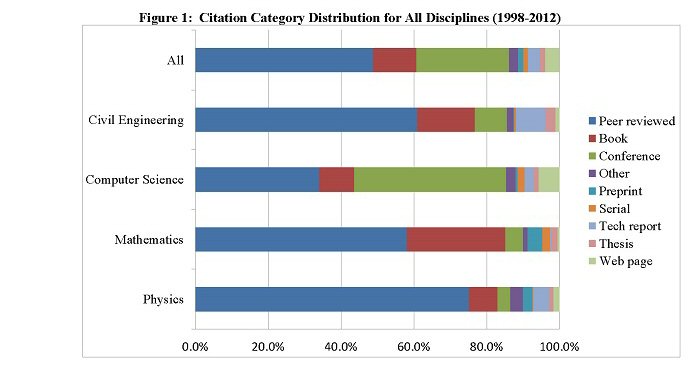
After examining the percent distribution of the combined categories for all four disciplines the following results were revealed:
- Peer reviewed was the most cited category for three of the four disciplines with the exception being computer science which placed conference papers in the overall top spot.
- Peer reviewed, books, and conference papers were included in the top three overall for all disciplines except for physics which placed tech reports ahead of books.
- The top three categories for all disciplines constitute 85.4% or more of the citations with the bottom six categories contributing less than 14.6% across all disciplines.
- Web pages were most popular in computer science.
- Preprints were most popular with mathematics researchers and least popular with civil engineering researchers. It's worth noting that none of the disciplines use preprints for more than 4.2% of their cited items.
- The discipline with the least percentage of usage for each of the nine citation categories are as follows:
- Book: physics
- Conference: physics
- Other: mathematics
- Peer reviewed: computer science
- Preprint: civil engineering
- Serial: physics
- Tech report: mathematics
- Thesis: physics
- Web page: mathematics
While there was some variation, it appears peer reviewed journal articles remain highly popular for dissertations in these disciplines. Books are especially popular for mathematics. Conference papers are ranked especially high for computer science dissertations. Items such as web page, preprint, serial and "other" categories are not as frequently cited. The Ohio State University required dissertations to be made freely available online since 2002 and theses since 2008 although embargoes are permitted. Although the number of full-text electronic dissertations via ProQuest has greatly increased during the 15-year span of this case study it's interesting to note that theses and dissertations were not cited more frequently.
Results: All Disciplines
The 609 dissertations investigated included civil engineering (58), computer science (298), mathematics (120), and physics (133) which produced more than 53,000 citations for analysis. The most frequently used citation categories for all disciplines (Figure 1) include peer-reviewed journal articles (48.9%), conferences (25.5%) and books (11.8%) resulting in 86.2% of the total distribution across all citation categories.
The citation category distribution indicates peer-reviewed articles are almost equal to all the other categories combined. This data clearly indicates peer-reviewed articles are actively cited by researchers. Conference materials represent one quarter of all citations across disciplines and indicate a strong preference with dissertation citations. These two categories combined represent almost 75% of all cited categories. The remaining seven categories total 25.5% of the total distribution. The book category contributed 11.8% to the total distribution while the least-ranked serials category contributed only 1.3%.
The highest ranked citation categories for each of the four disciplines include peer reviewed, conference, and book, respectively. When looking at the peer reviewed data, physics researchers (75.3%) clearly preferred this citation category more frequently than the other three disciplines. With the exception of physics, the other disciplines placed peer-reviewed journal articles, books, and conference papers, although not in the same rank order, within the most-cited categories. These category percentages combined per discipline range from 85.4% (civil engineering) to 90.0% (mathematics).
Within the disciplines, the preference results could have been influenced by a small number of researchers whose dissertations contributed more citations per dissertations when compared to other researcher's dissertations. Figure 2 represents the ranking position (1 most cited - 9 least cited) of each citation category over the 15-year period in terms of use. When reviewing the categories in rank order from highest to lowest popularity, peer-reviewed (48.9%), conference (25.5%) and book (11.8%) result in 86.2% of all categories combined.

The average item counts were then separated into two tiers representing the Top 3 Tier and the Bottom Tier. Although the book category has been in the Top 3 Tier (Figure 3) during the last 15 years, it has experienced slight increases and decreases during those years and ultimately has a slightly lower number of reported items than its initial reporting. The conference category in 1998 was an average of 19 items per year, but dropped in 2002 (12.5 items) only to reach its highest item count (31.4) in 2006. The peer reviewed category has also produced increases and decreases of reported items resulting in a sharp decline in 2011.
The Bottom Tier which includes all remaining categories combined equals 13.8% with individual categories ranging from 1.3 (serial) to 3.7 (web). Although it remains in the Bottom Tier, the web category has consistency experienced erratic increases and decreases of reported items during the 15-year period with 2008 indicating the highest number of items. Serials have remained one of the most stable categories exhibiting subtle changes over time.
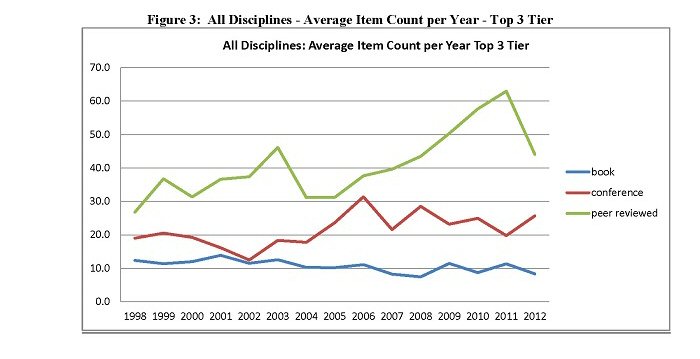
Results: Civil Engineering
The most frequently used civil engineering citation categories (Figure 4) are peer-reviewed journal articles (61.0%), books (15.8%), and conferences (8.8%) resulting in 85.6% of the total distribution across all citation categories. The remaining six categories saw a low of 0.3% (preprint) to 8.2% (tech reports) resulting in only 14.4% of the overall distribution. Although the conference category secured the third highest distribution, technical reports were cited 8.2% putting the category in a close fourth place. Serials and preprints combined represented less than 1% of the distribution.
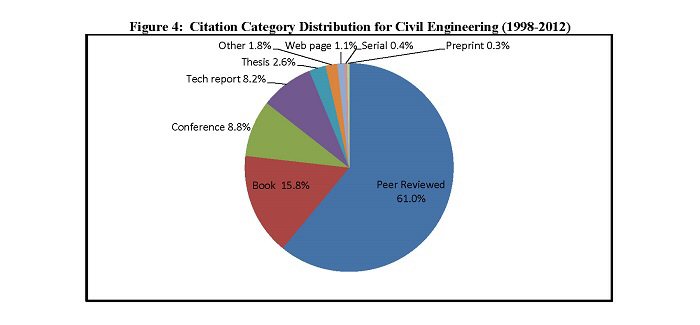
There were 58 civil engineering dissertations during the 15-year case study. The number of dissertations per year ranged from one in 2000 to nine in 2007 providing 5,140 total citations resulting in 88.6 average citations per dissertation. The citations per dissertation ranged from a low of 30 in 1999 to a high of 272 in 2009. Therefore, if the researcher with 272 citations used peer reviewed articles, her contribution to the total citations could skew the overall preferences for the discipline.
With regards to rank order, Figure 5 represents the position (1 most cited - 9 least cited) of each citation category over the 15-year period in terms of use. Within the rankings, the categories for book, preprint, technical reports, and web have increased in the rankings from their initial reporting in 1998. On the other hand, the conference and thesis categories have declined in rankings since 1998. Peer reviewed, serial and other categories have remained the same rank during the 15-year period.

The average item counts were then separated into two tiers representing the Top 3 Tier (Figure 6) and the Bottom Tier. The Top 3 Tier was analyzed to identify which years resulted in the high and low count by citation categories. The high count ranged from 17.5 (1998 conference paper) to 86.9 (2008 peer reviewed) while the maximum low count topped out at 15.0 (peer reviewed). The peer reviewed category is clearly the most frequently cited category although it continuously shows steep increases and decreases over time. Although in the Top 3 Tier, the categories of book and conference have experienced a slight overall decline in the number of reported items. The declines were influenced by less category usage, fewer dissertations and fewer citations per dissertations. Civil engineering dissertations, like mathematics, placed the top three citation categories in the same rank order.
The Bottom Tier provides data on the less frequently reported items which includes preprint, serial, technical reports, thesis and web categories. While a majority of the categories have slight increases in reported items over the years, the technical reports and web data show large jumps in frequency.

Results: Computer Science
The majority of citations (Figure 7) in computer science dissertations were conference papers (41.8%), peer-reviewed journal articles (34.1%), and books (9.5%). All other citation categories were at or under 5.6% each for a combined total of only 14.6% of total citations. Web pages totaled 5.6% resulting in a much higher distribution percentage than the other discipline dissertations. This is the only instance when the four examined disciplines placed conference papers as the top category for the fifteen year period.
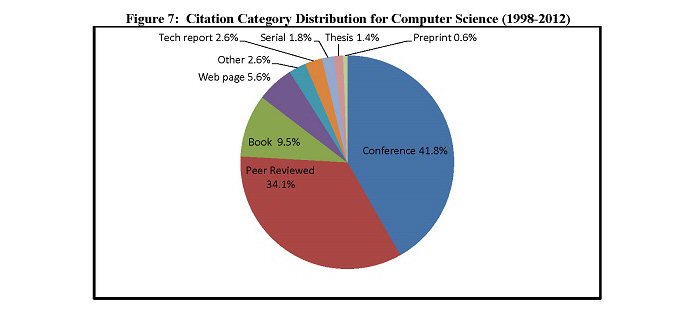
Figure 8 represents the rank position (1 most cited - 9 least cited) of each citation category over the 15-year period in terms of use. Conference papers and peer-reviewed journal articles cross over a few times through the years, but conference papers remain in first place for most of the years studied. Books consistently remained in third place except for 2008 when web pages jump into the top three tier.

Analyzing the top three cited categories (Figure 9), the average item count for each category varied greatly, with peer reviewed having the widest range. As observed by others (see literature review section), conferences taking first place for computer science is not uncommon.
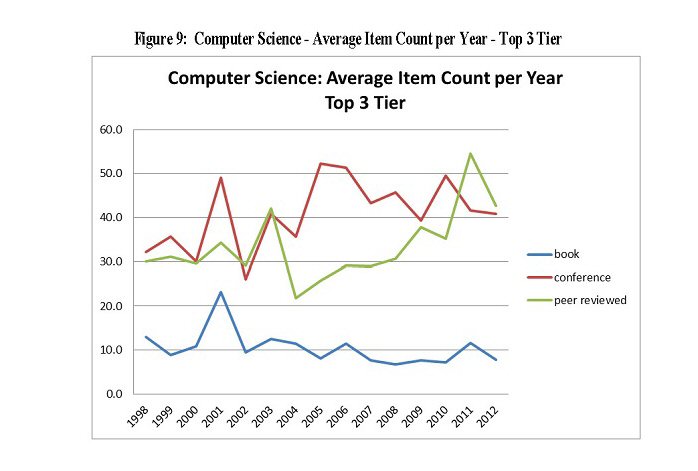
The bottom tier categories fluctuated from year to year with all items being within a range of less than 1.6 items. For technical reports, web pages, and "other," these citation categories had at least one year when there were no items cited. These bottom tier categories similarly fluctuated from year to year and has no clear ranking order since the citation categories regularly crossed paths. In 2003, the web page category becomes more predominate in the bottom tier while the additional categories continue to change rank more regularly.
Results: Mathematics
The majority of citations found in mathematics dissertations (Figure 10) were peer-reviewed journal articles (58.1%), books (27.1%), and conference papers (4.8%). All other categories were under 4.5% and totaled about 10% of the total citations.
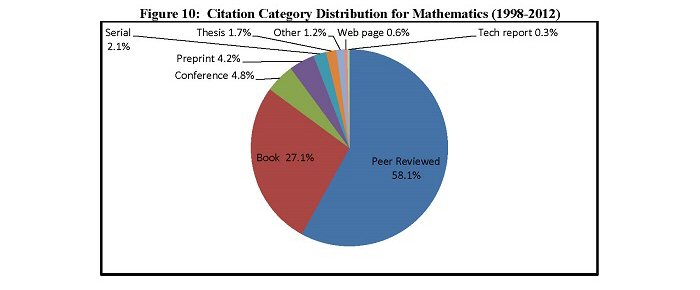
Figure 11 represents the position (1 most cited - 9 least cited) of each citation category over the 15-year period in terms of use. The peer reviewed and book categories were consistently in first and second place, respectively, throughout the period examined. While conference papers had the third highest category, it did not consistently remain in third place, crossing over with the additional citation categories and fell out of third place for several years when it was surpassed by preprints.

Top 3 Tier (Figure 12) gives a visual of the average number of citations for each of the three overall most-cited categories for mathematics over the years studied. The peer reviewed category was consistently higher than the others and showed the greatest range. For the remaining six categories, the average number of items per dissertation fluctuated from year to year with each category being within a range 1.6 items or less. While preprints overtook conferences for several years, the small variation means preprints did not make a significant jump in rank. Three categories consisting of tech report, web page and other had at least one year when there were no citations.

Results: Physics
For physics dissertations, the distribution across categories (Figure 13) resulted in peer-reviewed journal articles (75.3%), books (7.8%), and technical reports (4.4%) comprising 87.5%. The remaining categories made up only 12.5% of the citation categories. Unlike the other disciplines analyzed in this case study, technical reports were included in the Top 3 Tier. This is a stark difference from the other three disciplines, which all saw peer-reviewed journal articles, books and conference papers, although not in the same rank order, comprise the most-cited categories.
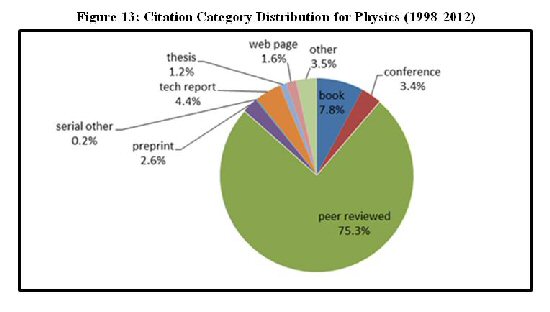
Again, the preference results could have been influenced by a small number of researchers who dissertations contributed more citations per dissertations when compared to other researcher's dissertations.
There were 133 physics dissertations during the 15-year case study. The number of dissertations per year ranged from three in 1998 and 2000 to 24 in 2010 providing 12,182 total citations resulting in 91.6 average citations per dissertation. The citations per dissertation ranged from a low of 24 in 2008 to a high of 397 in 2010. If the researcher with 397 citations used only peer reviewed articles, the volume of citations contributed to the case study could skew the overall preferences for the discipline.
Figure 14 represents the rank position (1 most cited - 9 least cited) of each citation category over the 15-year period in terms of use. Regarding physics dissertations, the peer-reviewed category has remained ranked first throughout the 15-year period. Within the rankings, the categories for thesis and other have jumped in the rankings from their initial reporting in 1998, while preprint, technical reports, and web have declined. The 2012 rank order for peer-review, conference and book categories remained the same as their 1998 ranking. Although serials started and ended in 8th place, the category dropped to last place 11 times throughout the case study.

The average item counts were then separated into two tiers representing the Top 3 Tier (Figure 15) and the Bottom Tier. The peer reviewed category indicates both increases and decreases over the years while experiencing an overall growth in items cited. The book and technical report categories have experienced slight fluctuations over the years, but they remain relatively flat. The declines were influenced by less category usage, fewer dissertations, and fewer citations per dissertations. The Bottom Tier indicates small increases in the reporting of items within the citation categories of serials, thesis, and web. The conference category experienced a spike in items from 2005-2007 and then declined by 2012. The Top 3 Tier was analyzed to identify which years resulted in the high and low count by citation categories. The high count ranged from a low of 9.4 (1999 technical reports) to 86.2 (2010 peer reviewed) while the maximum low count topped out at 19.7 (peer reviewed).
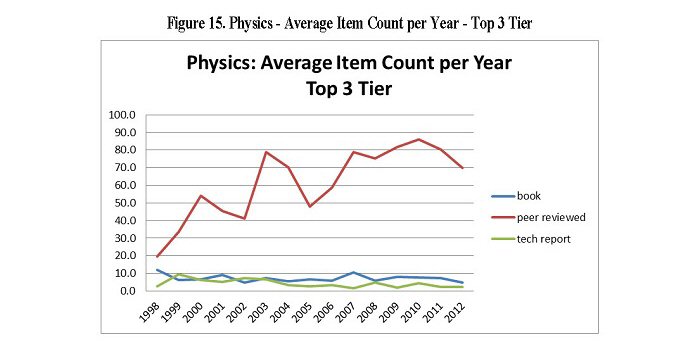
Conclusions
In this case study, civil engineering, computer science, mathematics, and physics dissertations were examined to determine what, if any, trends or patterns exist regarding specific citation categories of resources cited by Ph.D. students. The results provided overall summary comparisons in addition to discipline-specific results.
The four disciplines investigated within this case study represent a cross-section of sciences including both applied and physical. Each discipline was selected because the authors directly or indirectly serve as subject liaisons for those subjects or had previous experience working with the discipline. Civil engineering contributed only 58 dissertations to the case study which was the fewest number of the total dissertations. Computer science contributed almost half of the total dissertations while mathematics and physics posted similar results to one another.
Peer reviewed journal articles ranged from 34.1% (computer science) to 75.3% (physics) within the subject areas. For all disciplines combined, peer-reviewed journal articles comprised 48.9% of the items cited (far outpacing other categories) and this category was the most-cited category for three of the four disciplines (computer science being the exception, with conference papers taking the top spot). Physics preferred technical reports to books resulting in the only discipline to differ in the top-three categories.
When comparing overall rankings, the web pages category has clearly seen an increase in popularity jumping from 9th place in 1998 to 4th place in 2012. This may be a result of increased electronic access to scholarly works readily available from professional association web sites. Since this case study spans 15 years, the increase in web citations could simply be mirroring the improvements to technology and the comfort levels and experience of the researchers in the latter years.
An interesting result is the decline in usage of thesis and dissertations from 6th place (1998) to 8th place (2012) even though improved electronic access has increased availability during the 15-year period. Factors influencing the decreased usage may include the lack of relevant content, researcher knowledge of databases or the perspective that other graduate student work is not valuable. Although researchers often have easier access to dissertations through electronic databases, this citation category may continue to offer skewed results due to multi-year embargos that are in place. Such results could impact collection management decisions to acquire journal back files. It would be interesting to discover whether immediate access influences decisions for including or eliminating citations.
Information literacy is always a frequent conversation among academic librarians. The influence of institutional tradition toward usage of one category over another was not addressed in this case study; however, it may signal missed opportunities for librarians to become more actively embedded within the graduate student research process. Since there is a lack of qualitative research into the research behavior of STEM scholars, the authors are interested in determining whether researchers gravitate to citing articles because there is a long tradition for doing so or are there guidelines put forth by their advisors.
Appendix
Literature Review: Percentage of Total Citations for Articles, Books and Conferences and Top 4 Citation Categories Ranking
| Institution | Year Range |
Discipline |
Journal Articles |
Books |
Conference Papers |
Top 4 Citation Categories Ranking |
|---|---|---|---|---|---|---|
Bowling Green State University1 |
1980-2002 |
Mathematics and Statistics |
65.9* *Includes conference papers |
27.0 |
|
*Includes conference papers |
George Mason University2 |
2008-2012 |
Computer Science |
30 |
12 |
43 |
|
2008-2012 |
Electrical and Computer Engineering |
61 |
12 |
20 |
|
|
2005-2012 |
Systems Engineering and Operations Research |
30 |
22 |
16 |
|
|
2005-2012 |
Statistics |
59 |
25 |
6 |
|
|
2008-2012 |
Applied Information Technology |
27 |
16 |
30 |
|
|
Iowa State University3 |
1997-2006 |
Biological and Agricultural |
80.5 |
10.5 |
1.9 |
|
Karnatak University, Dharwad4 |
1992-2006 |
Physics |
80.54 |
10.95 |
3.17 |
|
Mississippi State University5 |
2000-2004 |
Aerospace |
31 |
22 |
22 |
|
Agriculture and Biology |
58 |
12 |
11 |
|
||
Chemical |
51 |
19 |
6 |
|
||
Civil |
26 |
22 |
9 |
|
||
Computational |
32 |
14 |
27 |
|
||
Electrical and Computer |
29 |
17 |
31 |
|
||
Industrial |
37 |
17 |
15 |
|
||
Mechanical |
35 |
20 |
22 |
|
||
Mississippi State University6 |
2002-2011 |
Chemical Engineering |
71.4 |
13.2 |
3.6 |
|
Chemistry |
87.1 |
7.1 |
2.0 |
|
||
New Mexico State University7 |
2009-2011 |
Multiple Engineering Disciplines |
70 |
10 |
9 |
|
1999-2001 |
48 |
23 |
15 |
|
||
1989-1991 |
44 |
28 |
14 |
|||
Ohio State University8 |
June – October 2005 |
All STEM |
75.87 |
13.66 |
7.63 |
|
University at Albany9 |
2000-2010 |
Atmospheric Science |
85.1 |
7.6 |
3.0 |
|
University of Notre Dame10 |
2005-2007 |
Aerospace and Mechanical Engineering |
59 |
22 |
9 |
|
Biological Sciences |
94 |
5 |
0 |
|
||
Chemical and Biomolecular Engineering |
88 |
9 |
0 |
|
||
Chemistry and Biochemistry |
95 |
3 |
0 |
|
||
Civil Engineering and Geological Sciences |
78 |
14 |
2 |
|
||
Electrical Engineering |
62 |
15 |
14 |
|
||
Computer Science and Engineering |
31 |
11 |
32 |
|
||
Mathematics |
51 |
34 |
4 |
|
||
Physics |
74 |
13 |
1 |
|
||
Western Michigan University11 |
2002-2006 |
Engineering and Applied Sciences - Masters |
29.9 |
20.5 |
12.5 |
|
Engineering and Applied Sciences - PhD |
44.3 |
17.3 |
21.9 |
|
||
Wuhan University12 |
2005 |
Biology |
90.82 |
4.65 |
3.92 |
|
Photogrammetry and Remote Sensing |
57.46 |
22.56 |
11.24 |
|
Note: Shaded entries indicate disciplines included in this case study.
1 Sinn (2005, 25)
2 Kelly (2015, n.p)
3 Kuruppu and Moore (2008, 393)
4 Hadagali, Kumbar and Benahal (2009, 117)
5 Williams and Fletcher (2006, n.p.)
6 Zhang (2013, 303)
7 Johnson (2013, 27)
8 Strader (2012, 243)
9 Kaczor (2014, 93)
10 Kayongo and Helm (2012, 56)
11 Eckel (2009, n.p.)
12 Gao, Yu and Luo (2009, 11)
References
Brown, C. 2003. The role of electronic preprints in chemical communication: Analysis of citation, usage, and acceptance in the journal literature. Journal of the American Society for Information Science and Technology 5(5): 362-371. DOI: 10.1002/asi.10223
Eckel, E.J. 2009. The emerging engineering scholar: A citation analysis of theses and dissertations at Western Michigan University. Issues in Science and Technology Librarianship. DOI: 10.5062/F4HD7SKP
Gao, S., Yu, W. & Luo, F. 2009. Citation analysis of Ph.D. thesis at Wuhan University, China. Library Collections, Acquisitions, and Technical Services 33(1): 8-16. DOI: 10.1016/j.lcats.2009.03.001
Hadagali, G.S., Kumbar, B.D. & Benahal, A. 2009. Citation analysis of PH.D. theses submitted to Karnatak University, Dharwad in the field of physics. Information Studies 15(2): 115-127.
Johnson, P.C. 2013. Dissertations and discussions: engineering graduate student research resource use at New Mexico State University. Collection Building. DOI: 10.1108/CB-09-2013-0037
Kaczor, S. 2014. A citation analysis of doctoral dissertations in atmospheric science at the University at Albany. Science & Technology Libraries 33(1): 89-98. DOI: 10.1080/0194262X.2013.866067
Kayongo, J. & Helm, C. 2012. Relevance of library collections for graduate student research: A citation analysis study of doctoral dissertations at Notre Dame. College & Research Libraries [Internet]. [Cited 2015 Feb 27]; 73(1): 47-67. Library Information Science & Technology Abstracts with Full Text. Ipswich, MA.: EBSCOhost; c2015. Available from: http://crl.acrl.org/content/early/2011/03/28/crl-211.full.pdf+html
Kelly, M. 2015. Citation patterns of engineering, statistics, and computer science researchers: an internal and external citation analysis across multiple engineering sub-fields. Preprint. College & Research Libraries. [Internet] [Cited 2015 Feb 27]. Available from http://crl.acrl.org/content/early/2015/01/01/crl14-600.full.pdf+html
Kuruppu, P.U. & Moore, D.C. 2008. Information use by Ph.D. students in agriculture and biology: A dissertation citation analysis. portal: Libraries and the Academy 27]; 8(4): 387-405. DOI: 10.1353/pla.0.0024
Sinn, R.N. 2005. A local citation analysis of mathematical and statistical dissertations. Science & Technology Libraries, 25(4): 25-27. DOI: 10.1300/J122v25n04_03
Strader, C.R. 2012. Citation analysis: Do age and types of materials cited correlate with availability of appropriate Library of Congress subject headings? Library Resources & Technical Services. 56(4): 238-253. DOI: 10.5860/lrts.56n4.238
Vallmitjana, N. & Sabate, L.G. 2008. Citation analysis of Ph.D. dissertation references as a tool for collection management in an academic chemistry library. College & Research Libraries. 69: 72-81. DOI: 10.5860/crl.69.1.72
Williams, V.K. & Fletcher, C.L. 2006. Materials used by master's students in engineering and implications for collection development: A citation analysis. Issues in Science and Technology Librarianship [Internet]. [Cited 2015 Feb 27]; 45. DOI: 10.5062/F4PG1PPR
Zhang, L. 2013. A comparison of the citation patterns of doctoral students in chemistry versus chemical engineering at Mississippi State University, 2002-2011. Science & Technology Libraries 32(3): 299-313. DOI: 10.1080/0194262X.2013.791169
Acknowledgement
The authors would like to acknowledge Bill Opperman who coded a portion of the physics citations.
| Previous | Contents | Next |

This work is licensed under a Creative Commons Attribution 4.0 International License.
